So you are walking through your local park and accidentally brush against some leaves. One minute your fine and then the next, you have rashes all over and itching like mad. Sounds like you have a case of poison ivy.
Facts About Poison Ivy
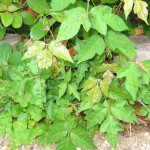 Poison ivy, otherwise known as Toxicodendron radicans, is a poisonous plant in North America that is known for its making of urushiol, a transparent liquid compound found within the sap of the plant that causes an itching rash. Here are 11 facts you need to know:
Poison ivy, otherwise known as Toxicodendron radicans, is a poisonous plant in North America that is known for its making of urushiol, a transparent liquid compound found within the sap of the plant that causes an itching rash. Here are 11 facts you need to know:
-
It is not contagious from person to another. You have to touch the plant.
-
Urushiol in Poison ivy can stay alive for 5 years including dead plants.
-
Breaking the blisters does not spread the Urushiol.
-
Direct contact is needed with the plant to get a poison ivy reaction.
-
90% of people have an allergic reaction to Urushiol oil. The more you are exposed to it increase the likelihood… So stay away.
-
Although poison ivy and oak have 3 leaves per cluster, poison sumac (which also spreads urushiol) may contain as many as 15 leaves per cluster. It is also possible for poison ivy and oak to have varied cluster formations that leave them with more or less leaves.
-
Poison ivy smoke is very dangerous and should be avoided it can cause internal and external injuries. Smoke carries the oil, producing a rash over 100 percent of the body. If you inhale the smoke, you can get the rash in your throat, bronchial tubes, and lungs. This can be fatal, especially if you’re camping out, where there’s no hospital.
-
It can grow as a vine, a small bush, and a shrub.
-
You do not get a poison ivy rash every year for 7 years once you come in contact with this plant, just the rash you have now.
-
You can get it in the winter. A ski-do driver accidentally broke a branch off and stuck it in his mouth, thinking he was idling chewing a stick, when in fact it was poison ivy. He had a severe reaction to the Urushiol. Dark, dense, hairy-looking aerial roots are a certain identifying characteristic in the winter
- Birds love the berries on the plant and it is none toxic. They spread the plant around through their droppings. The Chickadee and Downy Woodpecker, about 50 other bird species, including the Tufted Titmouse, Wren, Yellow-bellied Sapsucker, Robin, and Bluebirds eat this fruit. Poison ivy has some redemption.
Pictures – What does it Look Like
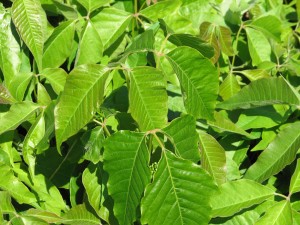 |
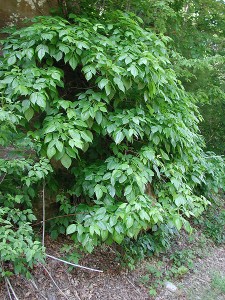 |
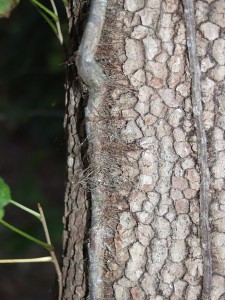 |
Best Natural Cure
If you think you might of touched it under 20 minutes ago scrub with soap, make sure it is an oil-less soap, brown soap is better and liquid Dish Soap is best. Then read the following natural cure for your poison ivy. Also, make sure you wash your clothes and shoes with hot water and soap!
What you will need:
1. White Vinegar
2. A Spray Bottle
4. Cotton Balls
5. Ice
6. Air
-
If the poison ivy is in a small area use some cotton balls and soak them in vinegar and tape it right over the affected spot and let it soak in for about 20 minutes. Do this a few times throughout the day and for the next few days. Note – this works for nasty insect bites too!
-
If it has spread and covers a large area of your body then place some vinegar in a spray bottle. You will have this little irritating disorder for possibly 2 weeks (14 days), so if you don’t have a spray bottle you might want to make the effort to run up to the nearest dollar store or hardware store and get one. It will make your life a lot easier for the next few days.
-
Once you have the vinegar in the bottle, spray a fine mist over the area that has the poison. Do this a few times so the skins absorbs it in. Grab some ice and put it on and it will take the swelling down.
Note – You will not walk around smelling like vinegar so do not worry about this.
-
Frequently spray the rash through out the day and for the next few days.
-
Keep the skin uncovered and well aired, a fan if applicable is good.
-
Keep the skin cool. Cool showers and cold swims work wonders and ice packs when needed.
-
You need to keep the rash out of the sun and not let yourself work up a sweat until this rash clears up. Keep yourself and the rash cool and airy on hot humid days.
-
This should help you out and bring you some instant desired relief. Otherwise you would have to look at alternative treatments and remedies for poison ivy.
Alternative Treatments And Home Remedies
The Jewel weed is an effective natural way to treat poison ivy, you can rub its sap on your affected skin area. You can also use some Jewel Weed products such as soaps, sprays, tinctures, salves etc. This remedy works best while your rash is new or fresh.
Other Home Remedies
- Tea tree oil is an amazing natural remedy that cures the painful and intense itching sensation that comes with having poison ivy. Applying tree oil every few hours for a whole day is guaranteed to make that itch go away and soothe the rash. Tree oil can also reduce the swelling that comes from poison ivy, making it the ideal natural remedy.
- Another natural remedy is to take Vitamin C with bioflavonoids, which can help with the swelling and the spreading of the infected area. The bioflavonoids help protect the Vitamin C from oxidizing in the body to help your body reap more benefits from the Vitamin C, while the Vitamin C boosts your immune system speeding up the healing process.
- If you are looking for a home remedy to purely get rid of the itching sensation, try this formula: 1 tablespoon of water with 3 tablespoons of one of these dry ingredients; cornstarch, baking soda, oatmeal or Epson salts. Make a paste and apply all over the area of skin that is infected with poison ivy. Doing this a couple times a day for a whole day should relieve the itch and get you to stop scratching.
Medical Treatments
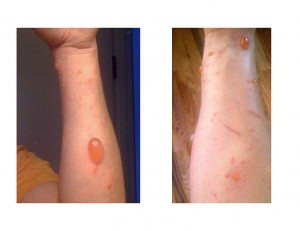
- If none of the home remedies suit your needs or do not live up to their name, you can always try over the counter medicine. The best over the counter medicine for poison ivy is Benadryl. Although Benadryl is mostly used as allergy medication, it can also be beneficial for those who are suffering from this condition because it can help soothe the itching and dry blisters that can occur.
Prescribed Medication
- If the side effects from poison ivy are severe, it is best to see a doctor right away who can prescribe you a more suitable treatment for your condition. A doctor will most likely prescribe an assortment of antibiotics and creams, however, in extreme cases; a doctor can give the patient a steroid shot and a cream called Diprolene AF.
Although poison ivy does not have serious consequences, if not treated properly, it can lead to other complications. If you become infected, start treatment right away or see a doctor as soon as possible.

